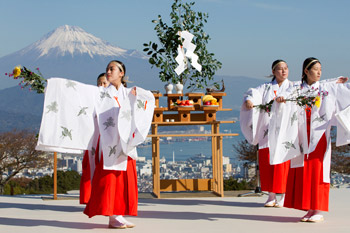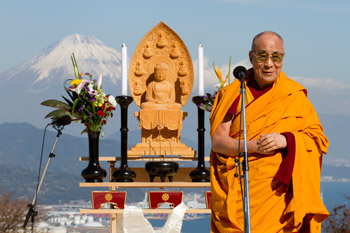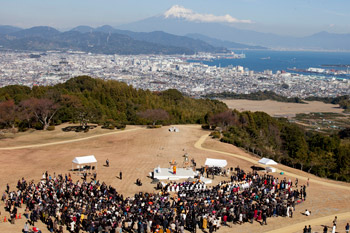Shizuoka, Japan, 22 November 2013 - When Mt Fuji was added to the World Heritage List as a cultural site in June this year it prompted another exciting idea. Save Tibet Network in conjunction with the Liaison Office of His Holiness the Dalai Lama for Japan and East Asia decided to convene an interfaith meeting focussed on world peace in the vicinity. In his introduction to the occasion today, Chairman of the Organizing Committee, Seishu Makino said that while it limited the size of event they could hold, the choice of Nihondaira as the location, in full view of Mt Fuji was an inspiration. The very name Nihondaira means ‘to pacify Japan’, making it an appropriate place to pray for peace in the world and Mt Fuji has been an object of pilgrimage for centuries. As everyone attending the gathering today witnessed for themselves, it is uplifting simply to gaze at its snow-capped cone aloft in the clear blue sky.

|
Women from the Shintoist tradition perform ritual prayers at the Interfaith Service for World Peace in Shizuoka, Japan on November 22, 2013. Photo/Office of Tibet, Japan
|
The Interfaith Service took as its motivation a maxim of Prince Shotoku, an early propagator of Buddhism in Japan - ‘Harmony is to be valued; avoidance of wanton opposition is to be honoured’. To begin with His Holiness participated in unveiling a statue embodying the spirit of Mt Fuji and draped it with a white silk scarf. Representatives of various religious traditions then performed prayers for world peace in their own style.
Ceremonies began with a group of Shintoists, both men and women, who made offerings, sang, danced and prayed, looking towards the holy mountain. They were followed by Christians who read from the Gospel according to Matthew, sang and recited the Lord’s Prayer in Japanese. They faced the people listening to them. A mixed group of Muslims performed unaccompanied prayers as they followed their imam’s lead.

|
Monks from a broad mix of Japanese Buddhist traditions reciting the Heart Sutra at the Interfaith Service for World Peace in Shizuoka, Japan on November 22, 2013.
Photo/Office of Tibet, Japan
|
Elaborately robed representatives of the ancient Buddhist mystical-spiritual tradition, Shugendo, arrived playing large conch shells. They too combined singing, prayer and various rites. Most striking was the ritual archer who let fly arrows in each of the four directions and the direction of the holy mountain. The richly robed Buddhist monks who came after them to recite the Heart Sutra represented a broad mix of Japan’s Buddhist traditions, including Shingon, Rinzai and Jodo shu. Finally, some Tibetan monks, led by His Holiness, recited the Heart Sutra once more in Tibetan.
After his companions had resumed their seats, His Holiness addressed the assembly of about one thousand people.
“Here, in view of Mt Fuji, we members of various religious traditions have gathered to make prayers for the lasting happiness of beings living on this earth. We have also prayed for the flourishing of the peace that is the basis of such happiness. All the world’s major religious traditions convey a similar message of love, compassion, tolerance and self-discipline. Therefore, it is very important that, despite their taking different philosophical approaches, these various traditions live in harmony with each other.
“Historically, it is the case that at times violent conflicts have broken out on the basis of religion. This is very sad, because what they have in common is the cultivation of love, compassion and forgiveness, values essential to the societies in which we live.”

|
His Holiness the Dalai Lama speaking at the Interfaith Service for World Peace in Shizuoka, Japan on November 22, 2013. Photo/Office of Tibet, Japan
|
He said that as a Buddhist monk he has met, held discussions and prayed with people belonging to many religious traditions. All of them serve their followers by teaching a moral path, which is fundamentally good. Hindus, Muslims and Jews, Christians, Buddhists and Jains all share the purpose of promoting love and compassion. They express different philosophical views because they have arisen in different places, at different times, among people with different mental dispositions; but their purpose remains the same. Therefore, it is important that harmony and respect flourish between them.
“In today’s world,” His Holiness said, “among us 7 billion human beings, many problems come about because we lack ethical standards; we lack even simple honesty. Therefore, we need to promote such values within our communities. And in that context, religious practitioners of religion should set an example of how to generate peace of mind. In order to demonstrate such qualities to others, you have to achieve inner peace yourself first. Without such peace within yourself, how can you reveal it to others?
“As a follower of the Buddha, this is what I try to do as best I can, and I request my spiritual brothers and sisters here to do the same. Thank you.”

|
View of Nihondaira, site of the the Interfaith Service for World Peace in Shizuoka, Japan on November 22, 2013.
Photo/Office of Tibet, Japan
|
There followed a sumptuous lunch of beautifully presented dishes, at the end of which His Holiness was called upon to say some concluding words.
“After this impressive prayer ceremony, we’ve had time to eat this delicious lunch together. I have to leave, because I’m going to Kyoto and I have a train to catch, but all of you please take your time and enjoy the meal. In view of this beautiful mountain, we were able to conduct this act of faith together, memory of which will remain with me for the rest of my life. Thank you.”
From Nihondaira His Holiness drove back down to Shizuoka city, where he caught the train that carried him to Kyoto. He was met on arrival by the Dean of Kyoto Seika University, his host during his stay in the city.